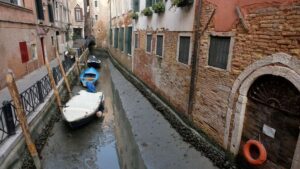
Venice, traditionally plagued by floods, has faced low water levels in its canals, so gondolas cannot move around the city, The Guardian newspaper reported.
“Weeks of dry winter weather have raised fears that Italy will face a serious drought again this year. In the Alps, for example, less than half of the winter rainfall has fallen, and in Venice gondolas cannot navigate some of the city’s famous canals because the water level has dropped too low,” the newspaper writes.
As the newspaper notes, the problems of Venice are caused by several factors – lack of rain, high pressure, sea currents and others.
Meanwhile, the drought affects not only the canals of Venice: the rivers and lakes in the north of the country are also acutely short of water.
According to environmentalists Legambiente, the water level in Italy’s largest river Po decreased by 61% compared to normal values for this time of year.
According to climatologist Massimiliano Paschi of the Italian research institute CNR, 500 mm of water needs to be restored in northwestern Italy, which is equivalent to 50 days of heavy rain.
In the summer of 2022, Europe was hit hard by the worst drought in 70 years. Some rivers and lakes dried up in the countries. In Italy and France, residents’ consumption of fresh water was limited.

After two years with a small-scale event, limited by health regulations due to COVID 19, the Carnival of Venice 2023 returned to Venice in all its unfading splendor for inhabitants and guests of the most romantic city in Italy, giving journalists reason to compare it to the mythical phoenix bird rising from the ashes.
Therefore, the color and sound performance of the opening in February on the canals of this eternal holiday had not only a special charm, but also a clear symbolic meaning that life wins. And Venetians make no secret of their joy that the carnival is once again taking place in its traditional form.
“It is a moment of self-identification for the people of Venice and for Venetians all over the world,” says Giovanni Gusta, municipal councilor in charge of Venice’s traditions.
The city on the water is dressed in bright colors, and its inhabitants in fantastic costumes that make you think everything happens in a fairy tale. And everywhere there are masks and masks. In public, in shop windows, on souvenir piles for tourists. Masks in the form of wall decorations, brooches, hairpins, bracelets and magnets.
A resident of Milan, Massimo Candelora, who came to Venice especially for the Carnival, claims that the masks evoke memories and nostalgia of the Venetians. After all, they have been worn in Venice since ancient times. “Today I’m in Venice, and I’m wearing a costume and a ‘bauta’ mask, a typical Venetian mask. It is a simple mask, but it could be worn even when other masks could not be worn. That’s why it is a unique and typically Venetian mask,” the Milanese explains.
A bauta is a papier-mache mask, usually white in color. It has a quadrangular shape, and its half, which covers the lower part of the face, is clearly protruding forward, leaving enough space to be able to drink and eat without removing the mask. In addition, this shape also changes the speaker’s voice, further enhancing his anonymity.
Over time, masks became an attribute of carnival. And before that, in economically prosperous Venice, hiding a person’s identity was commonplace in everyday life. It played a pragmatic role as people hid from competitors, envious people and stooges their deals, which were not necessarily in accordance with the laws of the time.
The carnival festivities will last until February 21, and until then, people in colorful costumes and the most unimaginable masks will be seen in Venice as a natural part of the cityscape, the local order and traditions.
Venice has regained its soul with the revival of carnival, say the Venetians.